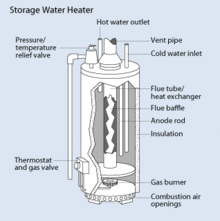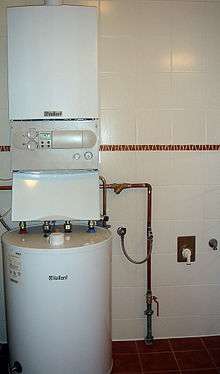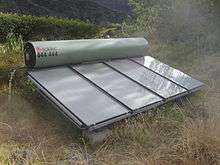Storage water heater

A storage water heater is a domestic water heating appliance that uses a hot water storage tank to maximize heating capacity and provide instantaneous delivery of hot water.[1] Conventional storage water heaters use a variety of fuels, including natural gas, propane, fuel oil, and electricity. Less conventional water heating technologies, such as heat pump water heaters and solar water heaters, can also be categorized as storage water heaters. Conventional storage water heaters are the most common water heating type used in the United States.[2]
Fossil fuel fired water heaters


Natural gas and propane storage water heaters operate identically with a gas or propane burner located at the bottom of the storage tank heating the water. Fuel oil fired storage water heaters are configured similarly by igniting a vaporizing mist of oil and air with an electric spark.[2]
Emissions from fossil fuel fired water heaters are expelled using a variety of venting technologies. Atmospheric vented systems use room air as combustion air and exhaust air. The exhaust air is expelled through the exhaust flue by buoyancy forces resulting from the combustion. Power vent models operate similarly to atmospheric vent systems, but an exhaust fan is added to aid in the expulsion of combustion gases. Direct vent systems do not use room air for combustion; instead, buoyancy forces air from the outside through the water heater combustion system and finally exhausts the combustion gases to the outside. Powered direct-vent systems include an exhaust fan to aid in the expulsion of combustion gasses.[3]
Electric water heaters
Most electric water heaters use electric resistance elements to heat the water in the storage tank using two electric resistance elements, which are located at the bottom and top of the storage tank. Each element is controlled by an independent thermostat. In two element tanks the lower element provides recovery from standby losses and the upper element provides heating during periods of large hot water use. Some resistance water heaters contain only a lower element.[2]
Water heaters that have residual hot water storage in a vessel/container heat, electrical water heaters can be a good match for an intelligent electrical power distribution system, heating when the electrical grid load is low and turning off when the load is high. This could be implemented by allowing the power supplier to send loadshedding requests, or by the use of real-time energy pricing. See Economy 7.
Heat pump water heaters use an air source heat pump to transfer thermal energy from the air around the unit into the storage tank. Electric resistance element(s) are typically included to provide backup heating if the heat pump cannot provide sufficient heating capacity.[4][5]
Solar


Increasingly, solar powered water heaters are being used. Their solar collectors are installed outside dwellings, typically on the roof or walls or nearby, and the potable hot water storage tank is typically a pre-existing or new conventional water heater, or a water heater specifically designed for solar thermal.
The most basic solar thermal models are the direct-gain type, in which the potable water is directly sent into the collector. Many such systems are said to use integrated collector storage (ICS), as direct-gain systems typically have storage integrated within the collector. Heating water directly is inherently more efficient than heating it indirectly via heat exchangers, but such systems offer very limited freeze protection (if any), can easily heat water to temperatures unsafe for domestic use, and ICS systems suffer from severe heat loss on cold nights and cold, cloudy days.
By contrast, indirect or closed-loop systems do not allow potable water through the panels, but rather pump a heat transfer fluid (either water or a water/antifreeze mix) through the panels. After collecting heat in the panels, the heat transfer fluid flows through a heat exchanger, transferring its heat to the potable hot water. When the panels are cooler than the storage tank or when the storage tank has already reached its maximum temperature, the controller in closed-loop systems will stop the circulation pumps. In a drainback system, the water drains into a storage tank contained in conditioned or semi-conditioned space, protected from freezing temperatures. With antifreeze systems, however, the pump must be run if the panel temperature gets too hot (to prevent degradation of the antifreeze) or too cold (to prevent the water/antifreeze mixture from freezing.)
Flat panel collectors are typically used in closed-loop systems. Flat panels, which often resemble skylights, are the most durable type of collector, and they also have the best performance for systems designed for temperatures within 100 °F (38 °C) of ambient temperature. Flat panels are regularly used in both pure water and antifreeze systems.
Another type of solar collector is the evacuated tube collector, which are intended for cold climates that do not experience severe hail and/or applications where high temperatures are needed (i.e., over 200 °F (93 °C)). Placed in a rack, evacuated tube collectors form a row of glass tubes, each containing absorption fins attached to a central heat-conducting rod (copper or condensation-driven). The evacuated description refers to the vacuum created in the glass tubes during the manufacturing process, which results in very low heat loss and lets evacuated tube systems achieve extreme temperatures, far in excess of water's boiling point.
References
- ↑ Hoeschele, M; Springer, D.; German, A.; Staller, J.; Zhang, Y. (August 2012). Strategy Guideline: Proper Water Heater Selection (PDF). Golden, CO: National Renewable Energy Laboratory. Retrieved 28 March 2013.
- 1 2 3 "Conventional Storage Water Heaters". eere.energy.gov. U.S. Department of Energy. Retrieved 28 July 2015.
- ↑ [http://www.centerpointenergy.com/staticfiles/CNP/Common/SiteAssets/doc/builder_water_heater[1].pdf "Natural Gas Water Heaters"] (PDF). Center Point Energy. Retrieved 28 March 2013.
- ↑ "Heat Pump Water Heaters". Retrieved 6 February 2014.
- ↑ Sparn, B., K. Hudon, and D. Christensen. (2014). Laboratory Performance Evaluation of Residential Integrated Heat Pump Water Heaters. Golden, CO: National Renewable Energy Laboratory.